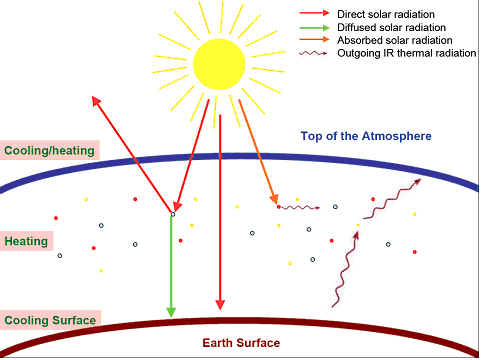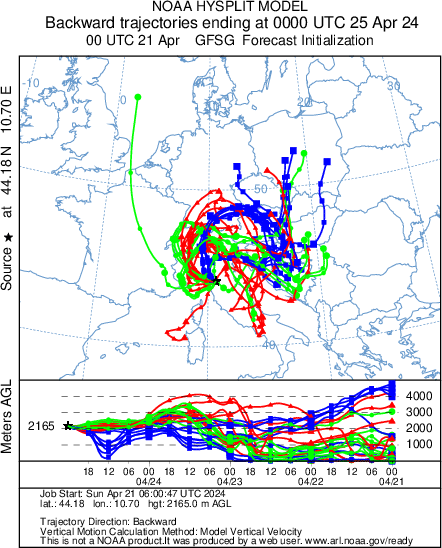Atmospheric aerosols are suspensions of solid and/or liquid particles in air. Aerosols are ubiquitous in the atmosphere and are often observable as dust, smoke and haze. Atmospheric aerosols have a multitude of effects on Earth’s climate, human health, visibility, continental and maritime ecosystems, air quality. Both natural and human processes contribute to aerosol concentrations. On a global basis, aerosol mass predominantly derives from natural sources, mainly sea salt and dust. However, anthropogenic (manmade) aerosols, primarily arising from a variety of combustion sources, can dominate in and downwind of highly populated and industrialized regions, as well as in areas of intense agricultural burning. Aerosol impact on climate is one of the most uncertain aspects of climate change, as reported by the Fourth Assessment Report of IPCC . 
Aerosols affect Earth’s energy budget directly by scattering and absorbing the incoming solar radiation and the outgoing thermal infrared radiation (the “direct effect”), which result in the cooling of the Earth's surface and in a possible heating of atmosphere/top of the atmosphere. Most aerosol species like sulfate, nitrate, sea-salt, dust (partly absorbing also) etc. scatter the radiation, whereas black carbon aerosols absorb the radiation. Moreover, aerosols affect climate by modifying amounts, microphysical and radiative properties of clouds (the “indirect effects”): indirect effects of aerosols include their influence on the radiation balance and hydrology through their impact on cloud microphysical processes (first indirect effect) and amount (second indirect effect). Moreover, aerosol particle can trigger a decrease of cloud amount ("semi-direct effect") by the heating resulting from the absorption of absorbing solar radiation. Due to the complexity and number of the atmospheric interactions involved, as well as the wide range of scales on which these interactions occur, the indirect effect is a significant source of uncertainty. In addition, depositions of aerosol such as black carbon and mineral dust onto snow-surface in the cryosphere may reduce the surface albedo. The impurity effect on snow albedo reduction is more important for visible wavelength than that for near infrared radiation. The effect increases heating of the snow and ice surface, thus accelerating melting, shortening snow duration, altering mass balance and causing the retreat of mountain glaciers. To better understand the impacts of aerosol particles on climate, extended measurements of aerosol properties and quantities are fundamental. In particular, mountain regions are representative of vast spatial areas, they are often in “clean” conditions and thus they constitute an extraordinary platform for monitoring climate change and its effects. There is a need to design efficient policies for monitoring of aerosols and their precursors and emission abatement strategies in order to understand regional to inter-continental transport of aerosols. The vast majority of current information comes from stations located in urban and peri urban areas and this information is often limited to regulated parameters, such as mass concentration. This is clearly not sufficient to provide the pertinent information of interest to air quality and climate studies. Variability of advanced aerosol variables, such as aerosol size distribution, chemical composition size segregated, degree of mixing, optical and hygroscopic properties is now required. For these reasons, at ICO-OV we monitor aerosol size distribution (since 2002 in the accumulation and coarse fractions, since 2005 also in nucleation and Aitken fractions), optical properties (scattering coefficient at 525 nm and absorption coefficient at 635 nm, corresponding to black carbon concentration; since April 2007) and chemical composition (organic and inorganic, not continuously).
For further information: a.marinoni [at] isac.cnr.it
Selected references
Marinoni, A, Cristofanelli P, Calzolari F, Roccato F, Bonafe' U, Bonasoni. P., 2008. Continuous measurements of aerosol physical parameters at the Mt. Cimone GAW Station (Italy - 2165 m a.s.l). Science of the Total Environment, 391.
Cristofanelli, P, Marinoni A, Arduini J, Bonafè U, Calzolari F, Colombo T, Decesari S, Duchi R, Facchini MC, Fierli F et al.. 2009. Significant variations of trace gas composition and aerosol properties at Mt. Cimone during air mass transport from North Africa – contributions from wildfire emissions and mineral dust. Atmos. Chem. Phys. 9. Marenco, F, Bonasoni P, Calzolari F, Ceriani M, Chiari M, Cristofanelli P, D’Alessandro A, Fermo P, Lucarelli F, Mazzei F et al., 2006.
Carbone, C, Decesari S, Mircea M, Giulianelli L, Finessi E, Rinaldi M, Fuzzi S, Marinoni A, Duchi R, Perrino C et al.. 2010. Size-resolved aerosol chemical composition over the Italian Peninsula during typical summer and winter conditions. Atmospheric Environment. 44(39):5269-5278.
Characterization of atmospheric aerosols at Monta Cimone, Italy, during summer 2004: source apportionment and transport mechanisms. J. Geophys. Res., 111(D24202).
Beine, HJ, Amoroso A, Esposito G, Sparapani R, Ianniello A, Georgiadis T, Nardino M, Bonasoni P, Cristofanelli P, Domine' F., 2005. Deposition of atmospheric nitrous acid on alkaline snow surfaces. Geophysical Research Letters, 32(L10808).




